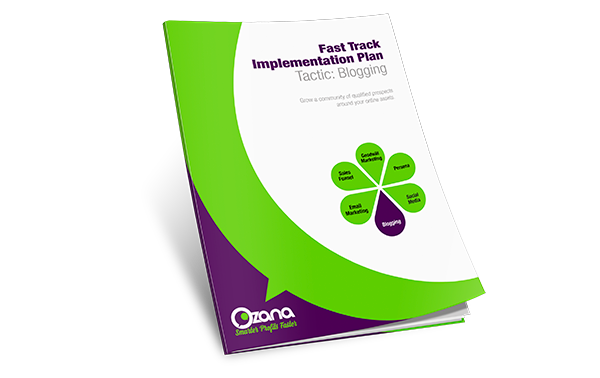Not Quite Getting This Blogging Thing? We Demystify It For You
Did you know that over a third of US companies already use blogs for marketing purposes? (source: eMarketer) Blogging is fast becoming an accepted – and expected – way for businesses to communicate with their customers (or target audience). Blogging has also evolved in leaps and bounds since the early days (thank goodness), when employees would be randomly assigned to throw together a few paragraphs about the company’s product, all with the aim to sell, sell, sell. Blogging today is an art and a skill. Mastering it will both strengthen your brand and attract more visitors to your website. (According to Hubspot.com, business blogging leads to a whopping 55% more website visitors.)
Reasons to get blogging properly
A blog can feel like just another item on your to-do list. You made the (smart) move to sell online and with that came a whole lot of other tasks and responsibilities. Or you’re thinking, My staff [or my budget] is stretched enough. Just because everyone is doing it, doesn’t mean I have to do it, right?
Problem is, if you’re not blogging – or are blogging badly – there’s a good chance you’re losing out on potential clients. (Rocketpost.com found that companies that blog generate 67% more leads a month than those that don’t.) And while your competitors are enjoying them, you’re missing out on these benefits of having a good company blog:
- Educate / motivate / inform your clients or customers
- Help your sales team generate qualified and educated leads
- Showcase your expertise and build trust
- Demonstrate thought leadership in your specific industry or specialty
- Increase (relevant) traffic to your website
- Have more content for your social media platforms
- Use as an additional channel for customer feedback
It may come as a relief though to hear that many companies are blogging badly. Some of the common reasons companies don’t see results from their blogs include:
- Having no clarity about why the company is blogging
- Not understanding how competitors use their blogs
- Not knowing how to write and publish blog posts, or improve existing ones
- Using weak titles that don’t draw readers in (or pushy titles that turn them off)
- Providing lacklustre content and articles that are either badly written or lack focus
- Not having a system in place to monitor and evaluate success; e.g. blogging is haphazard and done when someone gets round to it or realizes it hasn’t been done for a while
- Not sharing the blog on other blogs and/or on social media; i.e. leaving the blog to lie in isolation
- Relying on an already stretched staff to blog for the business or not having any decent writers in the team
If you’re going to blog (and yes, we believe you should), do it RIGHT
A strategically focused blog site with well-crafted blogs or articles that add value to your audience’s lives will deliver results, whether that means improving reputation, leads or sales – or all three. The first step, however, is to get clear on why you are blogging; only then can you develop a sure-fire strategy for your blogging activities.
Step 1: Get clear on your target audience
- Who are they? E.g. caterers looking for quality blenders.
- What are their main problems and needs? E.g. finding quality commercial blenders that are hardy enough for intensive use yet don’t cost and arm and a leg.
Step 2: Identify your overall blog content / themes
- What would they want to read about? E.g. new blender solutions, success stories, tips, recipes.
- What core topics could you write about to solve their problems or meet their needs? E.g. real-life stories of other caterers using your blenders, useful information about blenders including more ways to use them.
- How will your audience’s lives or businesses improve from reading your blog posts? E.g. peace of mind: able to produce items like smoothies on mass at catering events without worrying about blenders breaking down.
Step 3: Create a strong mission statement for your blog
- Why are you writing the blog? E.g. to educate / motivate / inform your clients or customers; to help your sales team generate qualified and educated leads… see the list of potential benefits of a blog above.
- Of these reasons, which are your top three priorities?
- Write that mission statement for your blog. It should be brief and communicate who your blog is for and why they should read it.
After going through this process with my team, we became very clear on the purpose of the Tooliers.com blog: It is for small business owners, to help them grow their companies by providing tips and tactics, the latest business discoveries and best practices, together with examples of how to use them. Going through this process has enabled us to focus: every blog post now has to meet these stringent criteria. Having a mission statement also makes it easier to brief external writers when we feel the need to use them, and to make sure guest bloggers stay on track with our mission too.
A blueprint for your blogging activities
Having gone through the whys, whens and hows of blogging, and radically transforming our blog site from inert to dynamic, we put together an Action Plan for our clients and other small businesses feeling overwhelmed by blogging or unhappy with their results. The Blogging Action Plan takes the confusion out of blogging by walking you through the entire process.
The Blogging Action Plan is:
- Easy to implement: Step-by-step actions guide you to developing your mission statement (as we’ve done here) and crafting perfect blogs that engage your target audience;
- Proactive: We make sure you get started ASAP. The Action Plan is centred on doing (and noton merely giving you more to read);
- Time-sensitive: Each step has a suggested time limit. We also provide strategies for getting staff on board with blogging as well as resources if you decide to look externally;
- Results-oriented: We help you clarify what you want out of your business blog and provide templates to help you monitor and evaluate your efforts.
Put an end to time wasted on reading blogs, books and reports and accumulating information you never benefit from.

Blogging is one of your most powerful weapons in your marketing arsenal. By the end of the Blogging Action Plan, your blog will have all the elements necessary to increase audience over time. You will also be one giant step ahead of your competitors.
If you’d like get blogging like a pro, try the Blogging Action Plan here.
Ps. Blogging Action Plan is part of a series of Action Plans we’ve designed to help small and medium businesses attract the right customers. If you’d like to focus on other key elements of effectively marketing your business, have a look at our other Action Plans here.

